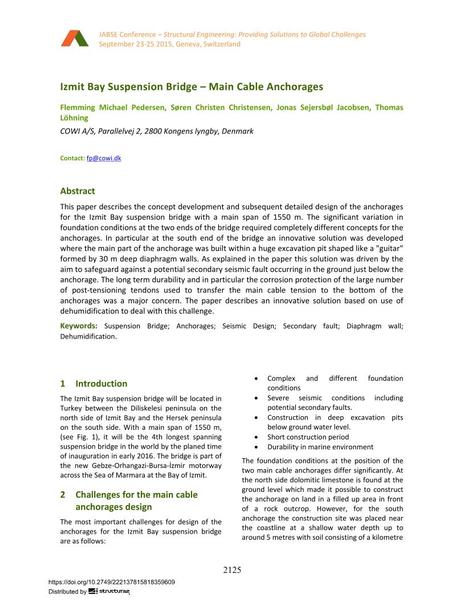Izmit Bay Suspension Bridge – Main Cable Anchorages

|
|
|||||||||||
Bibliographic Details
| Author(s): |
Flemming Pedersen
(COWI A/S, Parallelvej 2, 2800 Kongens lyngby, Denmark)
Søren Christensen (COWI A/S, Parallelvej 2, 2800 Kongens lyngby, Denmark) Jonas Jacobsen (COWI A/S, Parallelvej 2, 2800 Kongens lyngby, Denmark) Thomas Löhning (COWI A/S, Parallelvej 2, 2800 Kongens lyngby, Denmark) |
||||
|---|---|---|---|---|---|
| Medium: | conference paper | ||||
| Language(s): | English | ||||
| Conference: | IABSE Conference: Structural Engineering: Providing Solutions to Global Challenges, Geneva, Switzerland, September 2015 | ||||
| Published in: | IABSE Conference Geneva 2015 | ||||
|
|||||
| Page(s): | 2125-2132 | ||||
| Total no. of pages: | 8 | ||||
| Year: | 2015 | ||||
| DOI: | 10.2749/222137815818359609 | ||||
| Abstract: |
This paper describes the concept development and subsequent detailed design of the anchorages for the Izmit Bay suspension bridge with a main span of 1550 m. The significant variation in foundation conditions at the two ends of the bridge required completely different concepts for the anchorages. In particular at the south end of the bridge an innovative solution was developed where the main part of the anchorage was built within a huge excavation pit shaped like a "guitar" formed by 30 m deep diaphragm walls. As explained in the paper this solution was driven by the aim to safeguard against a potential secondary seismic fault occurring in the ground just below the anchorage. The long term durability and in particular the corrosion protection of the large number of post-tensioning tendons used to transfer the main cable tension to the bottom of the anchorages was a major concern. The paper describes an innovative solution based on use of dehumidification to deal with this challenge. |
||||
| Keywords: |
seismic design suspension bridge diaphragm wall dehumidification anchorages Secondary fault
|
||||

